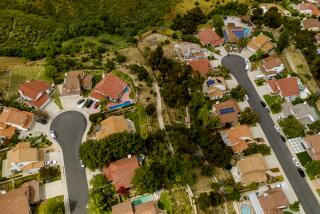From the Archives: Ku Klux Klan images from 1920s Southern California
During the 1920s, the Ku Klux Klan was very active in Southern California - especially in the city of Inglewood. Three of these images from the Los Angeles Times archives are related to an April 22, 1922, KKK raid in Inglewood that left one man dead.
In a May 30, 1999, article, Cecilia Rasmussen wrote about the raid:
…Inglewood--then the county’s agricultural hub--was the nation’s fastest-growing city. And to keep it a white Protestant town, klansmen posted signs that read “Caucasian-only.”
On a cold spring night--April 22, 1922--more than 100 armed and hooded klansmen broke into the Inglewood home of alleged bootleggers--Fidel and Angela Elduayer, Basque immigrants from Spain. The intruders forced the couple’s two teenage daughters to disrobe--contemporary accounts are silent on what may have followed--then ransacked the house and brutally beat Fidel and his brother, Mathias. When the Inglewood police arrived, shots were exchanged, leaving one klansman dead and two wounded.
Two days later, klan-sympathizing Inglewood residents--hostile and armed with pistols--jammed the tiny county coroner’s hearing room, where the victim’s body lay on a table in the corner. Maintaining the “night riders’ ” innocence, Grand Goblin William S. Coburn, head of the klan in California and five other states, declared that his men had only tried to “clean up the town’s bootleggers.”
But an Inglewood traffic cop, Frank Woerner, and a 19-year-old eyewitness, Clyde Vannatta, told another story: Woerner testified that on the night of the raid he had received a call from the Elduayers’ terrorized Japanese neighbor, who later hid with six small children in a nearby field. The officer hitched a ride outside Inglewood City Hall from Vannatta, who happened to be riding by on his motorcycle. Skidding to a stop at Pine Street, they were met by an armed group of hooded klansmen.
When the klan leader called out for the two to throw up their hands, Woerner replied, “Throw up your hands yourself. I’m an officer,” as he shined his flashlight on his badge.
But when the leader--who later was identified as Inglewood Constable Medford Mosher--made a threatening motion with his gun, Woerner drew his pistol and shot him dead as he and Vannatta quickly headed for cover.
An exchange of gunfire ensued; Woerner wounded Mosher’s son, Walter, in the arm and another klansman, Leonard Ruegg, in the groin.
While the gunfight continued, other klansmen ransacked the house, slashing the furniture and breaking everything in sight. They dragged the Elduayer brothers--bound, gagged and badly beaten--to a car and dumped them six miles away.
On the basis of testimony by Woerner and Vannatta, a grand jury was convened. Meanwhile, another foe of the klan, Los Angeles County Dist. Atty. Thomas Woolwine, launched an investigation along with state and federal agents. Ultimately, 150 reluctant klansmen were called to testify. Investigators from Woolwine’s office searched the klan’s headquarters in the Haas building at 7th Street and Broadway in Los Angeles. There, they found robes and hoods, crosses, membership cards and dues receipts of several hundred Los Angeles, Kern and Orange County men who had paid $10 to join. ….
While many KKK members were exposed, the group rebounded. They gained revenge by forcing Woolwine into retirement.
Following World War II, the Klan’s influence quickly faded in Southern California.
Rasmussen’s full 1999 article Klan’s Tentacles Once Extended to Southland is online.
See more from the Los Angeles Times archives here
More to Read
Start your day right
Sign up for Essential California for news, features and recommendations from the L.A. Times and beyond in your inbox six days a week.
You may occasionally receive promotional content from the Los Angeles Times.






